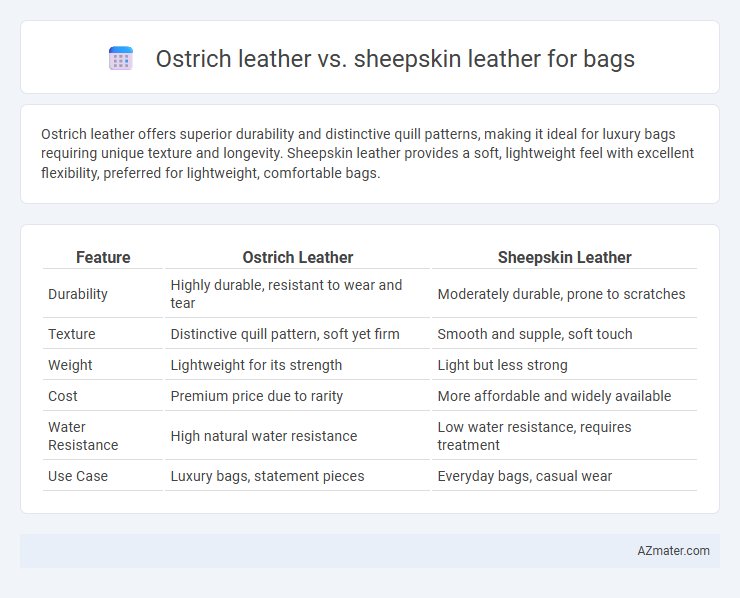Ostrich leather offers superior durability and distinctive quill patterns, making it ideal for luxury bags requiring unique texture and longevity. Sheepskin leather provides a soft, lightweight feel with excellent flexibility, preferred for lightweight, comfortable bags.
Table of Comparison
| Feature | Ostrich Leather | Sheepskin Leather |
|---|---|---|
| Durability | Highly durable, resistant to wear and tear | Moderately durable, prone to scratches |
| Texture | Distinctive quill pattern, soft yet firm | Smooth and supple, soft touch |
| Weight | Lightweight for its strength | Light but less strong |
| Cost | Premium price due to rarity | More affordable and widely available |
| Water Resistance | High natural water resistance | Low water resistance, requires treatment |
| Use Case | Luxury bags, statement pieces | Everyday bags, casual wear |
Introduction to Exotic and Traditional Leathers
Ostrich leather, an exotic material known for its distinctive quill follicle pattern, offers exceptional durability and a unique texture that stands out in luxury bags. Sheepskin leather, a traditional choice, provides a soft, supple feel with a smooth surface ideal for classic, comfortable designs. When comparing these leathers for bags, ostrich leather emphasizes uniqueness and longevity, while sheepskin leather highlights softness and everyday usability.
Overview of Ostrich Leather for Bags
Ostrich leather is prized for its distinctive quill follicle pattern, providing a unique texture and luxurious appearance perfect for high-end bags. Known for its durability, flexibility, and resistance to wear, ostrich leather offers a lightweight yet strong material that ages gracefully. This exotic leather is highly sought after in the fashion industry, delivering both premium quality and a statement of exclusivity for bags.
Overview of Sheepskin Leather for Bags
Sheepskin leather offers exceptional softness and lightweight qualities, making it a popular choice for luxurious and comfortable bags. Its fine grain and natural pliability provide a smooth texture and elegant appearance, while maintaining durability for everyday use. Compared to ostrich leather, sheepskin requires less intensive care but still delivers a stylish, supple finish often favored in high-end fashion accessories.
Durability: Ostrich Leather vs Sheepskin Leather
Ostrich leather exhibits superior durability compared to sheepskin leather due to its dense quill follicle pattern, which provides increased resistance to wear and tear. Sheepskin leather is softer and more pliable but tends to be less durable and prone to scratches and stretching over time. For bags requiring long-lasting strength, ostrich leather offers enhanced longevity and maintains its texture despite frequent use.
Texture and Appearance Comparison
Ostrich leather features a distinctive pattern of raised quill follicles, offering a highly textured, luxurious surface that enhances the visual appeal of bags with its unique dotted appearance. In contrast, sheepskin leather presents a smoother, softer texture with a natural grain that provides a sleek and elegant look, ideal for those seeking understated sophistication. Ostrich leather tends to showcase more durability and a striking, exotic aesthetic, while sheepskin emphasizes supple comfort and a classic, refined style.
Weight and Flexibility for Everyday Use
Ostrich leather is notably lightweight and offers impressive durability, making it an excellent choice for everyday bags that require both strength and a distinctive texture. Its natural flexibility allows the leather to conform comfortably without becoming stiff over time, contrasting with sheepskin leather, which is softer but generally heavier and less durable under constant use. Sheepskin leather tends to be more pliable initially but can wear faster, making ostrich leather preferable for those seeking a balance of light weight, flexibility, and long-lasting quality in daily carry items.
Cost and Availability of Ostrich vs Sheepskin Leather
Ostrich leather is significantly more expensive and less readily available than sheepskin leather due to its unique texture and limited sourcing. Sheepskin leather offers a more affordable option with widespread availability, making it a popular choice for bag manufacturers and consumers. The rarity and durability of ostrich leather contribute to its premium cost, whereas the abundance of sheepskin ensures consistent supply and lower prices.
Maintenance and Care Requirements
Ostrich leather requires specialized maintenance involving regular conditioning to preserve its unique quill patterns and prevent drying or cracking, making it ideal for luxury bags but demanding more care. Sheepskin leather is softer and more supple, with easier upkeep that includes gentle cleaning and avoiding excessive moisture, making it a practical choice for everyday bags. Both materials benefit from proper storage away from direct sunlight and humidity to maintain durability and appearance over time.
Environmental and Ethical Considerations
Ostrich leather is often praised for its durability and unique texture, but its environmental impact varies depending on farming practices, with some farms adopting sustainable methods to reduce land use and water consumption. Sheepskin leather generally involves lower environmental costs due to the widespread availability of sheep as a byproduct of the meat industry, minimizing waste and resource use. Ethical considerations favor sheepskin when sourced from suppliers with transparent animal welfare standards, while ostrich leather's ethical implications hinge on responsible farming and humane slaughter practices specific to the exotic leather industry.
Choosing the Best Leather for Your Bag
Ostrich leather offers exceptional durability and distinctive quill patterns, making it ideal for luxury bags that require both strength and unique aesthetics. Sheepskin leather is softer, more pliable, and lightweight, providing comfort and a smooth finish perfect for everyday or casual bags. Choosing between ostrich and sheepskin leather depends on your preference for durability and texture, with ostrich suited for high-end, long-lasting bags and sheepskin favored for its supple feel and ease of wear.

Infographic: Ostrich leather vs Sheepskin leather for Bag
 azmater.com
azmater.com